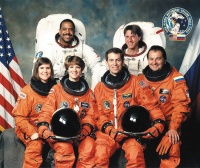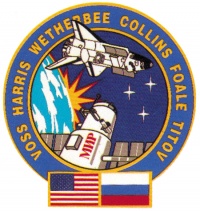STS-63
From The Space Library
 | |
| Organization | NASA-Office of Space Flight (United States) |
|---|---|
| Mission type | Human Crew |
| Launch date | February 3, 1995 |
| Launch vehicle | Space Shuttle |
| Launch site | Cape Canaveral, United States |
| COSPAR ID | 1995-004A |
| Inclination | 51.6 degrees |
| Experiments | Here |
| Alternate Names | 23469 |
| Additional Information | Here |
| Data Collection | Here |
| Payload Mass Up | 8641 kg |
| Payload Mass Down | 8633.64 kg |
| Orbiter | Discovery |
| Lift Off Mass | 2,050,673.18 kg |
| Orbiter Weight at Liftoff | 112,489.09 kg |
| Orbiter Weight at Landing | 96,035.45 kg |
| Landed | Concrete runway 15 at Kennedy Space Center, Fla. |
| Orbits of Earth | 130 |
| Orbital Altitude | 170-213 nautical miles (196-245 statute miles) |
Contents |
[edit] Crew
- Commander: James D. Wetherbee
- Pilot: Eileen Marie Collins
- Payload Commander:
- Mission Specialist 1: C. Michael Foale
- Mission Specialist 2: Janice E. Voss
- Mission Specialist 3: Bernard A. Harris Jr.
- Mission Specialist 4: Vladimir Titov, Russian Space Agency
- Mission Specialist 5:
- Payload Specialist 1:
- Payload Specialist 2:
ISS/Mir Crew Transport
[edit] Mission
STS-63 was the first Shuttle flight of 1995 and included several history-making achievements: First flight of a female Shuttle pilot (Eileen M. Collins) and, as part of Phase I of international space station program, the second flight of a Russian cosmonaut (Vladimar Titov) on a Shuttle misson, and first approach and flyaround by a Shuttle with the Russian space station Mir. Beginning on flight day one, a series of thruster burns were performed daily to bring Discovery in line with Mir. Original plan called for the orbiter to approach to no closer than 10 meters, or 32.8 feet, from Mir, and then complete a flyaround of the Russian space station. However, three of the 44 orbiter Reaction Control System (RCS) thrusters -- small firing jets used for on-orbit maneuvering --sprang leaks prior to rendezvous. Shortly after main engine cutoff, two leaks occurred in aft primary thrusters, one of which -- called R1U -- was key to therendezvous. A third leak occurred later in the flight in the forward primary thruster, but the crew was able to fix the problem. After extensive negotiations and technical information exchanges between US and Russian space teams, the Russians concluded a close approach could be safely achieved and the STS-63 crew was given 'go' to proceed. The R1U thruster manifold was closed and a backup thruster was selected for approach. Ship-to-ship radio contact with Mir was achieved well ahead of time, and Titov, who lived on Mir for more than a year, communicated excitedly with three cosmonauts aboard the space station: Mir 17 Commander Alexander Viktorenko; Flight Engineer Elena Kondakova; and Valery Polyakov, a physician who has broken Titov's record for extended time in space. After stationkeeping at a distance of 400 feet (122 meters) from Mir and with Wetherbee manually controlling orbiter, Discovery was flown to 37 feet from the Russian space station. "As we are bringing our spaceships closer together, we are bringing our nations closer together," Wetherbee said after Discovery was at the point of closest approach. "The next time we approach, we will shake your hand and together we will lead our world into the next millenium." "We are one. We are human," Viktorenko responded. Wetherbee then backed away to 400 feet (122 meters) and performed one and a quarter-loop flyaround of Mir while the station was filmed and photographed. The Mir crew reported no vibrations or solar array movement as a result of the approach. The crew also worked extensively with payloads aboard Discovery. Flying in the forward payload bay and activated on flight day one was SPACEHAB-3. The commercially-developed module was making its third flight on the Shuttle and carried 20 experiments: 11 biotechnology experiments; three advanced materials development experiments; four technology demonstrations; and two pieces of supporting hardware measuring on-orbit accelerations. Improvements were made to the SPACEHAB system to reduce demand on crew time. A new video switch was added to lessen the need for astronaut involvement in video operations, and an experiment interface was added to the telemetry system to allow an experiment investigator to link directly via computer with the onboard experiment to receive data and monitor status. Charlotte, an experimental robotic device being flown for first time, also will reduce crew workload by taking over simple tasks such as changing experiment samples. Among plant growth experiments were Astroculture, flying for the fourth time on Shuttle. The objective of Astroculture was to validate performance of plant growth technologies in microgravity environment of space for application to a life support system in space. The investigation has applications on Earth, since it covers such topics as energy-efficient lighting and removal of pollutants from indoor air. One of the pharmaceutical experiments, Immune, also has Earth applications. Exploiting known tendency of spaceflight to suppress immune system, the Immune experiment tested the ability of a particular substance to prevent or reduce this suppression. Clinical applications could include treatment of individuals suffering from such immunosuppressant diseases such as AIDS. On flight day two, the crew deployed Orbital Debris Radar Calibration System-II (ODERACS-II) to help characterize orbital debris environment for objects smaller than 10 centimeters (about four inches) in diameter. A complement of six target objects of known dimensions and with limited orbital lifespans were released into orbit and tracked by ground- based radars, allowing precise calibration of radars so they can more accurately track smaller pieces of space debris in low Earth orbit. Also on flight day two, the crew lifted with the orbiter remote manipulator system arm the SPARTAN-204 from its support structure in payload bay. SPARTAN remained suspended on the arm for observation of orbiter glow phenomenon and thruster jet firings. SPARTAN-204 was later released from arm to complete about 40 hours of free-flight, during which time its Far Ultraviolet Imaging Spectrograph instrument studied celestial targets in the interstellar medium, the gas and dust which fills the space between the stars and which is the material from which new stars and planets are formed. SPARTAN-204 was also used for extravehicular activity (EVA) near end of flight. Foale and Harris began EVA suspended at end of robot arm, away from payload bay, to test modifications to their spacesuits to keep spacewalkers warmer in extreme cold of space. Two astronauts were then scheduled to practice handling approximately 2,500-pound (1,134-kilogram) SPARTAN to rehearse space station assembly techniques, but both astronauts reported they were becoming very cold -- this portion of the walk was performed during a night pass -- and mass handling was curtailed. This 29th Shuttle spacewalk lasted 4 hours, 38 minutes. Harris was the first African-American to walk in space. Other payloads included: Along with ODERACS-II, Cryo System Experiment (CSE) and Shuttle Glow (GLO-2) payloads were mounted on Hitchhiker support assembly in the cargo bay; an IMAX camera was also located here. In middeck, Solid Surface Combustion Experiment (SSCE) flew for the eighth time. The Air Force Maui Optical Site (AMOS) test required no onboard hardware.
[edit] EVA
Extravehicular Activity (EVA) conducted by Bernard Harris and Michael Foale, 4 hours, 39 minutes. Harris and Foale evaluated spacesuit modifications that would provide astronauts with better thermal protection from cold and practiced handling large objects in space in order to increase NASA's experience base as it prepares for the on-orbit assembly of the International Space Station. The EVA was terminated prematurely when Harris and Foale reported they were getting too cold.
[edit] Payload
SPACEHAB 03; Shuttle Pointed Autonomous Research Tool for Astronomy (SPARTAN) 204; Cryo Systems Experiment (CSE)/GLO-2 Experiment Payload (CGP)/Orbital Debris Radar Calibration Spheres (ODERACS) 2; Solid Surface Combustion Experiment (SSCE); Air Force Maui Optical Site (AMOS); IMAX Cargo Bay Camera (ICBC)
[edit] Books about the Space Shuttle Program
Buy This Book Click here |
Buy This Book here |
Buy This Book Click here |
Buy This Book Click here |





